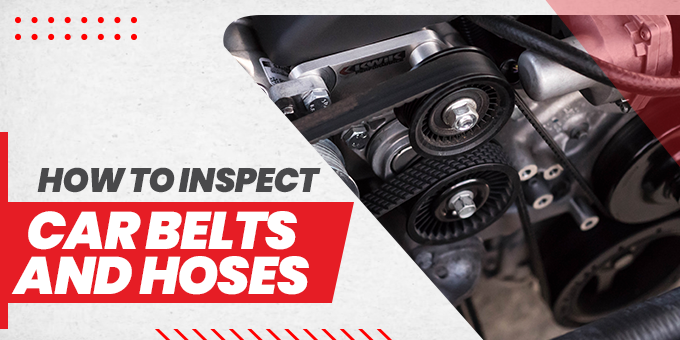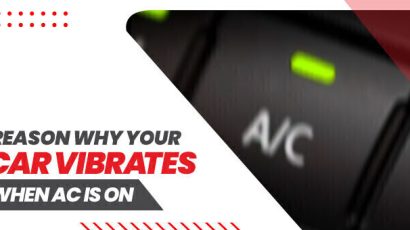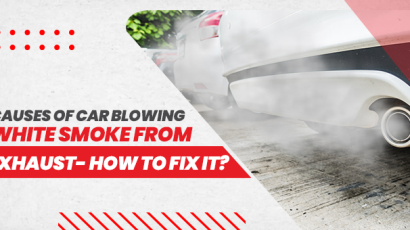
Among all your car’s equipment, belts and hoses are the most likely to be damaged due to their constant exposure to heat and chemicals. If they are not properly looked after, your vehicle’s performance can be severely damaged. In addition, they can cause serious internal damage to your car, which will require hefty repairs.
Failure of a car’s belts and hoses can cause your steering to lose its power, the electrical system to lose its charging capabilities, and the engine to get overheated. Your car is more likely to get overheated in summers as the high temperature under the hood triggers the deterioration of rubber components.
If the belt responsible for pumping water breaks or gets frayed or the hose starts to leak the coolant, then the cooling system of your car will be straight up inoperable. In this blog, we’ll talk about some must-know factors that you should know to inspect your car’s belts and hoses.
How to Inspect Car’s Hoses
Hoses are the weakest component of the car’s cooling system as they are made of flexible rubber material. Its making allows it to absorb any vibrations caused by the engine, radiator, or the body’s firewall.
They are designed to hold the coolant and maintain resilience when subjected to extreme temperatures, dirt, and oil. If your car is becoming beyond repair, then head to our website and buy a second-hand car for sale.
However, being in constant contact with unfavorable conditions, they tend to wear off after some time. The worst type of hose damage is ECD-electrochemical degradation- which is rather hard to detect.
It damages the hose from the inside, causing tiny cracks, so when the coolant becomes contaminated from other chemicals mixing up in it, the material from which the hose is made up of eventually gets badly ruptured.
Here are some of the very basic steps you can follow to inspect the hose of your car:
- The first thing you should do is regularly check up on the coolant recovery tank to ensure that the fluid is filled to a proper level.
- The marks present on the coolant recovery tank indicate whether the engine is hot or cold. If you inspect your car and see the heat level increase, then it is time for you to replace the hose.
- If the fluid in the tank is low even though you constantly fill it up, then perhaps there may be a leak, in which case you’d have to look for a new hose and refill the coolant with new fluid as per the manufacturer’s manual.
- Another thing that you can do is to see for any blue-white or green coolant marks on the engine as they indicate residue from a leaking hose.
- When your engine cools down, squeeze the hose near the clamps and feel for any soft spots. If you find any, then there may be a chance of electrochemical degradation.
- Inspect the hose for any frays, cracks, oil contamination, or collapsed parts near the connection points.
- If the hose has a glassy surface, then that means that there is heat damage.
- If you find cracks around the bends, then that means that the hose was damaged due to ozone.
- The upper radiator hose has a higher tendency to fail; after that comes the water pump hose and then the outlet heater hose.
- It is recommended to replace the hose every four years or when one of the hoses fails.
- While looking for a new hose in the market, look for those that are designed to resist electrochemical degradation. You can check that by looking for a Type C label on the packaging of the hose.
How to Inspect Car’s Belts
Just like the hose, car belts are also damaged due to extensive exposure to heat, abrasion, and oil. Almost all cars have these serpentine belts that are responsible for keeping the power-steering and water pump, compressor, and alternator.
Belts are likely to fail at 36,000 and can reach a critical stage till 50,000 miles. If a belt seems very frayed during your inspection, you should immediately replace them, but many belts don’t show any signs of damage until the failure occurs.
Here are some tips for inspecting a belt before any serious damage to the engine occurs:
- Look for cracks, holes, frays, and glaze on the belt. A slick belt can snap or overheat anytime.
- Turn the belt over and look at the separating layers for any fissures and pieces of grooves underneath.
- When replacing the serpentine belts, buy the ones that are the same in length and width as compared to the factory belt.
- Car’s belts are usually kept taut, so if you hear a high-pitched noise from the hood, then it indicates that the belt has lost some of its tension and can slip.
Conclusion
We often think that tires are the only rubber component present in our cars, but they are far from being the only ones. Under the hood of your car, there are many components that contribute towards a smoother, safer, and comfortable ride. One of those components is hoses and belts.
If you are driving an advanced automobile, then it will have a single serpentine/drive/accessory belt. This belt is in charge of the alternator, water and engine pump, and the air conditioner compressor. Vehicles of the older make and models have several V-belts instead of just one. Each of those belts will be controlling different controls of the car.
All cars have a timing belt that synchronizes the movement of the crankshaft and the camshaft to ensure all of the engine’s components are moving in the same cycle. The timing belt differs with the car as some have rubber ones and the other has metal chains.
On the other hand, hoses are essential for cooling down the engine. Upper and lower radiators are manufactured in a way so that they can handle excessive heat and pressure and can carry a hot engine’s coolant efficiently. Heater hoses are just like upper and lower radiators, but instead of transporting the coolant to the engine, they transport it to the heater core.
Other than that, we have power steering, vacuum hose, brake lines, and fuel lines connecting the fuel tank to the engine.
While the hoses and belts are manufactured to last a long time and resist harsh conditions, they are not guaranteed to last forever. Therefore, you should have a professional check-up on them every now and then.
If you have driven your car for about 60,000 miles or six years, then it is recommended that you have your car scheduled for a check-up if you haven’t already. If you notice some wear and tears, then that is when you should be looking towards replacing them to ensure that your car does not suffer from any serious internal damage.
If you realized a little too late that the car’s belts and hoses have internally damaged your car and they now call for hefty maintenance you are looking forward to, then head to our website today to get access to a wide range of economical, good condition second-hand cars for sale.











